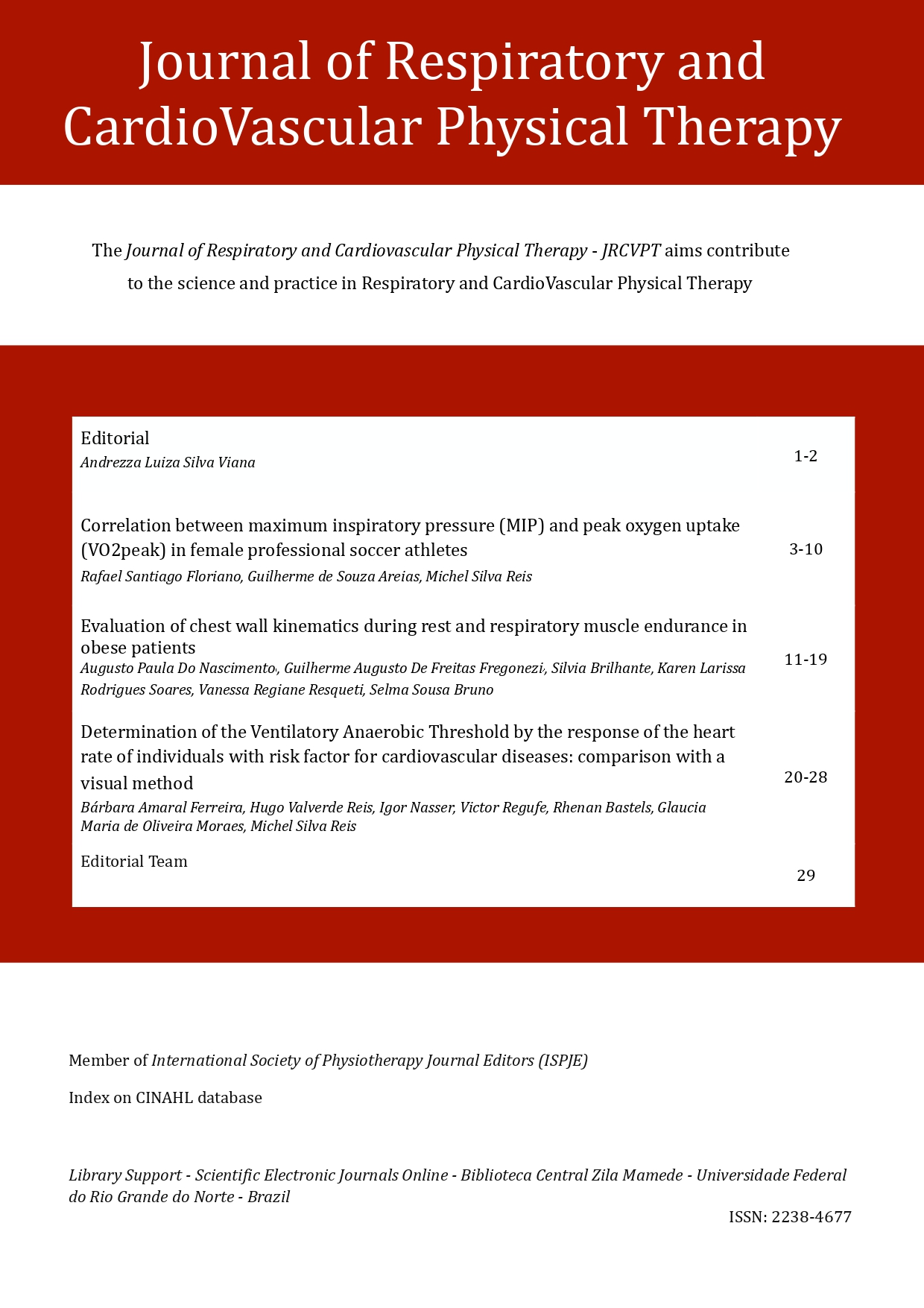English
Resumo
Fundamentação: O treinamento muscular ventilatório (TMV) tem sido descrito como uma estratégia para melhorar a força e a resistência muscular ventilatória e periférica de atletas de diferentes modalidades. Entretanto os mecanismos envolvidos neste processo não são totalmente conhecidos. O consumo de oxigênio (VO2) é a variável padrão ouro para a avaliação da capacidade funcional. O oxigênio (O2) para ser consumido pelos músculos periféricos precisa transpor o sistema cardiorrespiratório. Neste racional parece lógico que quanto mais fortes forem os músculos da inspiração, maior será o VO2. Este trabalho demonstrou que isto pode não ser tão determinístico quanto parece. Objetivo: Avaliar a correlação entre a força muscular respiratória, através da pressão inspiratória máxima (PImáx) e o consumo de oxigênio no pico do exercício (VO2 pico) em mulheres atletas de futebol profissional. Desenho do Estudo: Estudo retrospectivo e transversal. Métodos: 18 jogadoras de futebol profissional, do sexo feminino e idade entre 18 e 40 anos (26 ± 4.3), foram submetidas a aferição da pressão inspiratória máxima (PImáx -120.7±16.9) e realizaram o teste de exercício cardiopulmonar (TECP) em esteira rolante, onde foram aferidas as variáveis ventilatórias e metabólicas. Uma delas foi o VO2pico (44.30±5.9). A partir destes resultados realizamos a correlação entre estas duas importantes variáveis. Todos as voluntárias foram avaliadas no mesmo horário do dia, pelo mesmo avaliador e com o mesmo equipamento, da seguinte forma: (i) avaliação da força muscular ventilatória; e, (ii) teste de exercício cardiopulmonar incremental até a tolerância máxima. Importância do Estudo: Este estudo pode contribuir e revelar que tipo de correlação existe entre estes importantes marcadores e se podemos afirmar que a força muscular inspiratória influencia no VO2, auxiliando assim na utilização de novas estratégias de treinamento muscular ventilatório à técnicas consagradas, visando a melhora da performance no esporte. Resultados: As voluntárias apresentaram a Pimáx de -120.7±16.9 e no TECP em esteira rolante obtiveram um VO2pico de 44.30±5.9. Em seguida a análise estatística demonstrou a correlação entre estas duas variáveis..Conclusão: Houve uma correlação negativa entre a PImáx e o VO2pico, onde parece que a força muscular inspiratória não influencia no VO2pico.
Downloads
Downloads
Publicado
Como Citar
Edição
Seção
Licença
Copyright Transfer Statement
The author(s) of the article, as specified here, hereby transfer(s) to the Revista de Fisioterapia Respirtória e CardioVascular (Journal of Respiratory and CardioVascular Physical Therapy) all copyright ownership rights, title and interests that the author(s) may have or may come to have in and to the article and any revision or version thereof, including, but not limited to, exclusive right to print, publish and sell the article anywhere in the world, in any language and in any media.
This agreement will be considered effective and valid if and when the article is accepted for publication.
If the article contains any copyright-protected material from a third party, the author(s) must obtain written permission to reproduce the said material in the article from the copyright holder and send it to the Revista de Fisioterapia Respirtória e CardioVascular (Journal of Respiratory and CardioVascular Physical Therapy).
The author(s) guarantee(s) the holding of proprietary rights to the article; not having granted or transferred any rights to the article to any other persons or entity; that the article is susceptible to the demand for rights by its author(s); not having infringed upon any author rights, trademark or patent; not having violated the right to privacy or publicity of any person or entity; that the article does not contain any defaming subject; that the factual statements made are true or are based on reasonably accurate research; and, finally, that, the author(s) has/have no reason to believe that any of the formulas, procedures or prescriptions contained in the article will cause damage if used or followed in accordance with the instructions and warnings contained in the article.
The author(s) will indemnify the Revista de Fisioterapia Respirtória e CardioVascular (Journal of Respiratory and CardioVascular Physical Therapy) against any costs, expenses, damages or liability that the Revista de Fisioterapia Respirtória e CardioVascular (Journal of Respiratory and CardioVascular Physical Therapy) may incur as a result of accidental omissions of these guarantees. These representations and guarantees may be extended to a third party by the Revista de Fisioterapia Respirtória e CardioVascular (Journal of Respiratory and CardioVascular Physical Therapy).
Date:
Note: Each author must individually complete and sign this form
1) Author:
Signature: _________________________________
2) Author:
Signature: _________________________________
3) Author:
Signature: _________________________________
4) Author:
Signature: _________________________________
5) Author:
Signature: _________________________________
6) Author:
Signature: _________________________________
7) Author:
Signature: _________________________________
8) Author:
Signature: _________________________________




 English
English Español (España)
Español (España) Português (Brasil)
Português (Brasil) Français (Canada)
Français (Canada)